IDEX Online Research: Total US Jewelry Sales Up in June, But Specialty Jewelers’ Sales Decline
August 15, 16
Tougher comparisons against last year’s strong sales coupled with declining sales at specialty jewelers resulted in only a moderate sales gain in June for the US jewelry industry.
Total sales of fine jewelry and fine watches in the US market rose by 3.5 percent in June 2016 when compared to June 2015, according to preliminary data from the US Department of Commerce. This gain was below the solid gains in the past couple of months, but more in line with the increases posted in the December 2015-March 2016 period.
By category, fine jewelry sales and fine watch sales were each up about 3.5 percent in June. Watch sales have been outpacing jewelry sales for a number of months, but demand for watches has slowed somewhat, according to both the government survey and our panel of jewelers.
June is a relatively important month for the US jewelry industry: just over 7 percent of the industry’s annual sales occur during the month. In fact, it is the strongest month of the sequence of five months beginning June and ending October. The summer doldrums set in during July, and shoppers simply don’t think about jewelry until November, the beginning of the holiday selling season.
Preliminary June sales gains for specialty jewelers show that they are continuing to lose significant market share to other merchants – mostly multi-line retailers – who sell jewelry. Specialty jewelers, who generate a majority of their business from jewelry sales, posted a decline in sales of 2.2 percent, the first drop since January. This is a significant deceleration of sales trends in prior months this year by specialty jewelers.
Other retailers who sell jewelry – mostly multi-line merchants such as Wal-Mart, J.C. Penney, and others – posted a very strong 7.4 percent gain in sales during June.
Our outlook calls for more moderate sales increases – perhaps in the 3-percent range – over the next few months, primarily because comparisons are much more difficult against solid growth in the second half of last year. Further, as the number of specialty jewelers declines, their aggregate sales levels will continue to diminish or show only modest monthly gains.
Total Jewelry Sales Up 3.5 Percent in June
Total sales of fine jewelry and fine watches in the US market in June 2016 were an estimated $5.7 billion, according to the latest preliminary data from the Department of Commerce.
Specialty jewelers, who derive a majority of their revenues from the sale of fine jewelry and watches, posted a decline in sales of 2.2 percent in June, when compared to the same month a year ago. Specialty jewelers’ sales represent about 40 percent of total US jewelry sales.
Retailers such as Wal-Mart, Costco, and others who sell jewelry generated an estimated jewelry sales gain of 7.4 percent during the month of June. Jewelry sales through multi-line merchants represent about 60 percent of total US jewelry sales, a number that has been growing for several decades.
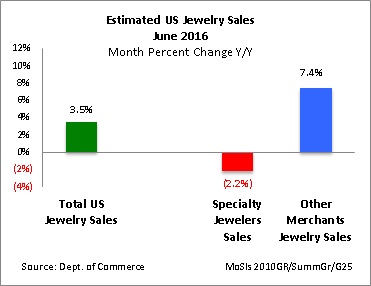
Consumer Spending on Jewelry Weaker Than Expected in June
Consumer demand for jewelry has been showing growth, especially over the past seven months. However, June’s moderate sales gain was disappointing. In part, this is due to tougher sales comparisons against last year’s stronger gains in the later part of the year.
There also appears to be some slowdown in demand for low-priced charm-and-bead jewelry, according to reports from both publicly held and privately held jewelers in our sample. These negative factors are offset by some broad-based trends. For example, the US economy appears to be posting moderate, but consistent, growth. Further, employment levels continue to strengthen. We also sense that some diamond promotions are beginning to have a positive impact on consumer demand; in addition, fashion jewelry remains a strong category at multi-line merchants.
Figure 2 shows year-over-year percent changes in monthly fine jewelry and watch sales in the US market since the beginning of 2015. It is clear that jewelry sales gains moderated in June.
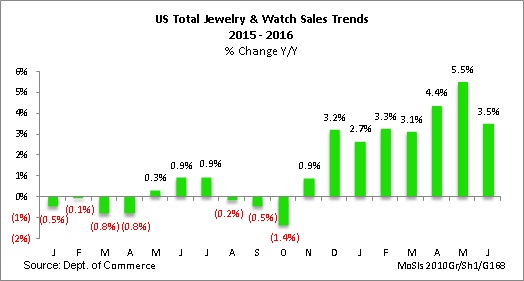
Fine jewelry sales (approximately 88 percent of the market) rose by an estimated 3.5 percent in June, while fine watch sales were also up by 3.5 percent.
Figure 3 compares fine jewelry sales gains (red bars) to fine watch sales growth (blue bars). We note that the LGI/NPD Network showed that branded jewelry sales were down 8 percent in June and branded watch sales were down 2 percent. Demand for branded goods apparently was soft in June.
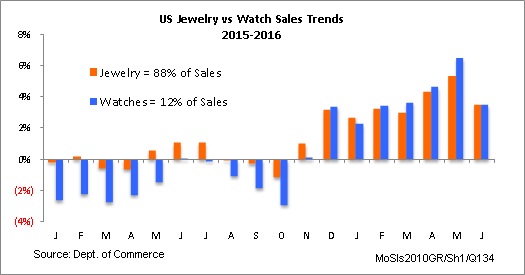
Specialty Jewelers’ Sales Decline in June
Specialty jewelers’ sales during June were an estimated $2.2 billion, a 2.2 percent decline from June 2015, as Figure 4 illustrates. This monthly sales decline was well below the overall jewelry industry average (all US retailers who sell jewelry) sales gain of 3.5 percent for June. Specialty jewelers’ sales trends are disappointing.
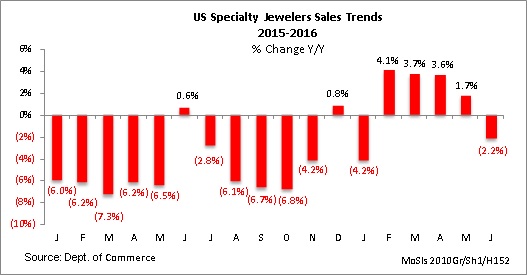
Figure 5 compares specialty jewelers’ sales trends to multi-line merchants who also sell jewelry. Since June of 2015, specialty jewelers (red columns) have lost market share every month, when compared to multi-line retailers of jewelry (blue columns).
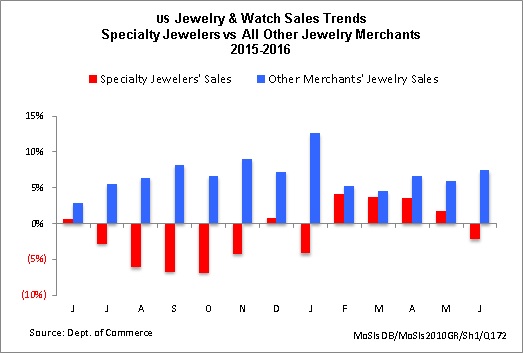
Jewelry’s Share of Wallet Was Flat in June
Total US jewelry sales rose by 3.5 percent in June. This was in line with the average retail sales gain (all retail categories) of 3.5 percent posted by all US retail merchants. As a result, the US jewelry industry neither gained nor lost share of wallet from other retail merchants.
In Figure 6, jewelry sales gains are represented by the red bar; total retail sales gains are represented by the green bar.
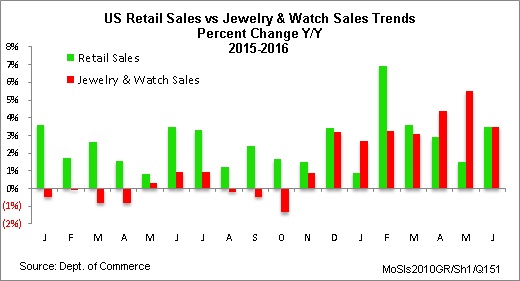
Outlook – We Remain Optimistic
Despite weaker-than-expected results in June, the US retail jewelry sector has been relatively robust since the all-important 2015 November-December period, based on revised data.
Our preliminary sales forecast for the US jewelry industry for 2016 calls for a gain of 3 percent or greater for the full year, unchanged from last month. While our full year jewelry sales forecast may seem conservative, year-over-year sales comparisons become much more difficult in subsequent months.